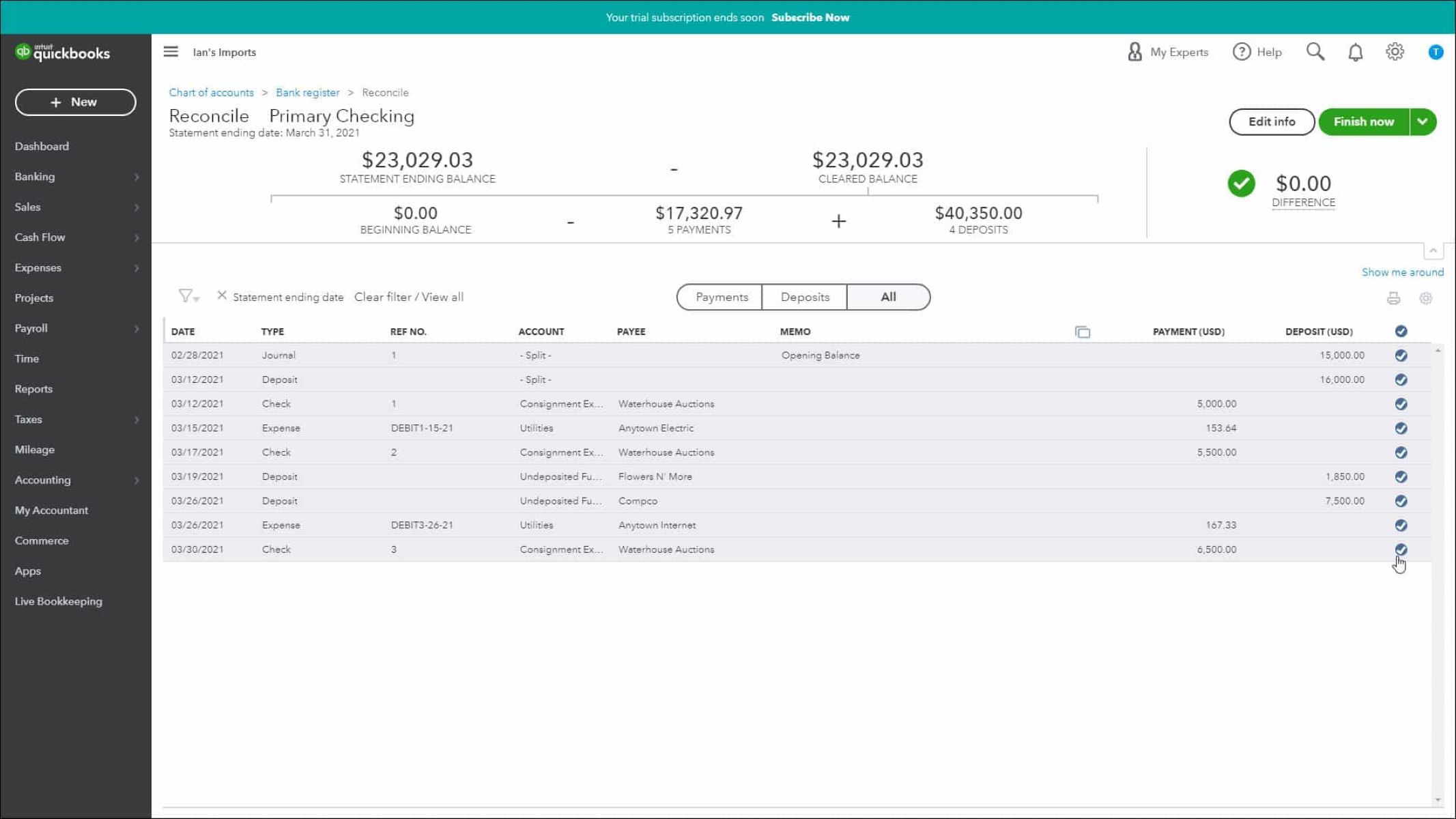Introduction
Welcome to our guide on how to reconcile credit cards in QuickBooks Online. If you’re a business owner or an accountant using QuickBooks Online to manage your company’s finances, it’s important to regularly reconcile your credit card accounts. Reconciliation ensures that the transactions in QuickBooks Online match those on your credit card statements, which helps maintain accurate financial records.
Reconciling your credit card accounts may seem daunting at first, but with the step-by-step instructions we’ve provided in this guide, you’ll be able to reconcile your credit card accounts efficiently and effectively. By performing regular reconciliations, you can identify any discrepancies or errors promptly, helping to prevent any potential issues or misunderstandings with your finances.
In this guide, we’ll walk you through the process of reconciling your credit card accounts in QuickBooks Online, from setting up credit card accounts to verifying the reconciliation results. By following these steps, you’ll be able to ensure that your credit card transactions in QuickBooks Online align with your credit card statements, providing you with a clear and accurate financial overview of your business.
Ready to get started? Let’s dive into the step-by-step process of reconciling your credit cards in QuickBooks Online.
Step 1: Set Up Credit Card Accounts in QuickBooks Online
The first step in reconciling your credit cards in QuickBooks Online is to set up your credit card accounts within the software. This allows you to track and record your credit card transactions accurately. Here’s how to set up credit card accounts:
- Log in to your QuickBooks Online account and navigate to the “Settings” menu.
- Select “Chart of Accounts” from the menu options. This will display a list of your existing accounts.
- Click on the “New” button to create a new account.
- From the account type dropdown menu, choose “Credit Card” as the account type.
- Enter a suitable name for the credit card account, such as the name of the credit card issuer.
- Provide the necessary details, such as the credit card account number and the opening balance.
- Save the account to finish setting up your credit card account.
By setting up your credit card accounts correctly in QuickBooks Online, you’ll be able to easily categorize and track your credit card transactions. This will facilitate the reconciliation process in subsequent steps, as QuickBooks Online will have accurate records of your credit card activities.
Once you have set up your credit card accounts, you’re now ready to move on to the next step: downloading your credit card transactions.
Step 2: Download Credit Card Transactions
After setting up your credit card accounts in QuickBooks Online, the next step is to download your credit card transactions. This allows you to import the most up-to-date transaction data directly into QuickBooks Online, saving you time and reducing the risk of manual data entry errors. Follow these steps to download your credit card transactions:
- Access your credit card provider’s online banking portal and navigate to the transaction history or statement section.
- Select the appropriate date range for the transactions you want to download. It’s advisable to choose the same period that you’ll be reconciling.
- Look for an option to export or download the transactions. Choose a compatible file format, such as CSV or QBO, which is supported by QuickBooks Online.
- Save the downloaded file to your computer’s designated folder for QuickBooks import files.
- Open QuickBooks Online and navigate to the “Banking” or “Transactions” menu.
- Select “File Upload” or “Upload File” and choose the downloaded file from your computer.
- Follow the prompts to map the columns in the file with the corresponding fields in QuickBooks Online. Ensure that the appropriate account is selected for the credit card transactions.
- Review and confirm the imported transactions to ensure accuracy.
By downloading your credit card transactions directly into QuickBooks Online, you eliminate the need for manual data entry and reduce the chance of errors. This streamlines the reconciliation process and helps ensure that your credit card transactions are accurately reflected within QuickBooks Online.
With your credit card transactions imported, you’re ready to move on to the next step: matching them with your credit card statement.
Step 3: Match Transactions with Credit Card Statement
Once you have downloaded your credit card transactions into QuickBooks Online, the next step is to match those transactions with your credit card statement. This process helps ensure that the transactions recorded in QuickBooks Online accurately reflect the transactions on your statement. Here’s how to match transactions with your credit card statement:
- Go to the “Banking” or “Transactions” menu in QuickBooks Online.
- Select the relevant credit card account for which you want to match transactions.
- You’ll see a list of imported credit card transactions. Review each transaction and compare it with your credit card statement.
- If a transaction is already listed in QuickBooks Online and matches a transaction on your statement, mark it as “Matched” or “Cleared.”
- If a transaction is listed in QuickBooks Online but hasn’t cleared on your statement yet, mark it as “Uncleared.”
- If a transaction is missing from QuickBooks Online but is present on your statement, locate the missing transaction and add it manually. Ensure that the transaction details match those on your statement.
- Continue this process until you have reviewed and matched all transactions in QuickBooks Online.
Matching your credit card transactions with your credit card statement helps reconcile the two and ensures your financial records in QuickBooks Online are accurate and up-to-date. You may encounter discrepancies during this process, such as missing or mismatched transactions. Make note of any discrepancies for further investigation and resolution.
With your transactions matched and cleared, you’re ready to proceed to the next step: reconciling your credit card accounts in QuickBooks Online.
Step 4: Reconcile Credit Card Accounts
Once you have matched your credit card transactions with your credit card statement, it’s time to reconcile your credit card accounts in QuickBooks Online. Reconciliation is the process of ensuring that the transactions recorded in QuickBooks Online align with the transactions on your credit card statement. Follow these steps to reconcile your credit card accounts:
- Go to the “Banking” or “Transactions” menu in QuickBooks Online.
- Select the credit card account you want to reconcile.
- Click on the “Reconcile” button, which will open the reconciliation window.
- Enter the statement date and ending balance from your credit card statement.
- Review the list of transactions that have been matched or cleared. Ensure that the total matches the statement’s beginning balance plus any additional charges.
- If there are any discrepancies or missing transactions, locate and resolve them before proceeding.
- Click on the “Finish Now” button to complete the reconciliation process.
Reconciling your credit card accounts in QuickBooks Online helps ensure the accuracy of your financial records. It allows you to identify any discrepancies and resolve them promptly, providing you with a clear and up-to-date understanding of your business’s financial health.
Once you have reconciled your credit card accounts, it’s time to move on to the final step: verifying the reconciliation results.
Step 5: Verify Reconciliation Results
After reconciling your credit card accounts in QuickBooks Online, the final step is to verify the reconciliation results. Verifying the results ensures that the reconciliation was successful and that your credit card accounts are accurately reflected in QuickBooks Online. Here’s how to verify the reconciliation results:
- Go to the “Banking” or “Transactions” menu in QuickBooks Online.
- Select the credit card account that you recently reconciled.
- Click on the “Reconciliation” tab to access the reconciliation summary.
- Review the reconciliation summary, which will display the statement date, ending balance, and any adjustments made during the reconciliation process.
- Ensure that the “Statement Ending Balance” matches the actual ending balance on your credit card statement.
- Verify that the “Difference” is zero or close to zero. If there is a significant difference, double-check your transactions and reconcile again if necessary.
- Check that all the previously matched and cleared transactions have been properly reconciled.
- If everything looks correct, congratulations! Your credit card account is now reconciled in QuickBooks Online.
Verifying the reconciliation results gives you peace of mind that your credit card accounts in QuickBooks Online are accurate and in line with your credit card statements. It allows you to confidently use QuickBooks Online for financial reporting, making informed business decisions based on accurate and reliable data.
If you notice any discrepancies or issues during the verification process, take the time to investigate and resolve them. This may involve reviewing transactions, contacting your credit card provider, or seeking assistance from a financial professional if needed.
With the reconciliation results verified, you have successfully completed the process of reconciling your credit cards in QuickBooks Online.
Conclusion
Reconciling credit cards in QuickBooks Online is an essential task for maintaining accurate and up-to-date financial records. By following the step-by-step process outlined in this guide, you can ensure that your credit card transactions in QuickBooks Online align with your credit card statements.
Throughout this guide, we covered the key steps to reconcile credit card accounts in QuickBooks Online:
- Set up credit card accounts in QuickBooks Online to accurately track your transactions.
- Download credit card transactions to import the most recent data into QuickBooks Online.
- Match transactions with your credit card statement to ensure accuracy.
- Reconcile credit card accounts in QuickBooks Online to verify the transactions.
- Verify the reconciliation results to ensure the accuracy of your financial records.
By diligently following these steps, you can reduce the risk of errors, identify discrepancies, and maintain a clear and accurate picture of your company’s financial health. Regularly reconciling your credit card accounts will also help you identify any potential issues with your finances, enabling you to take the necessary steps to address them swiftly.
Remember, staying on top of your credit card reconciliations is crucial for effective financial management. Make it a habit to reconcile your credit card accounts regularly, such as on a monthly basis, to ensure the integrity and accuracy of your financial data.
We hope this guide has proven helpful in guiding you through the process of reconciling credit cards in QuickBooks Online. Mastering this essential skill will save you time, minimize errors, and provide you with reliable financial information for informed decision-making in your business.
Happy reconciling!

























